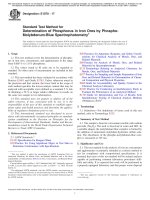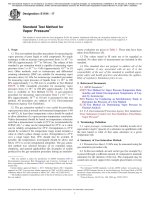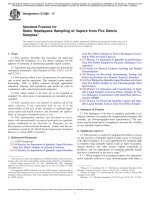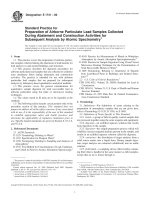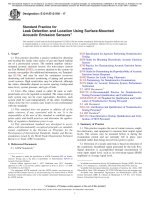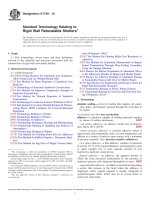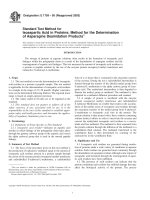Astm e 1186 17
Bạn đang xem bản rút gọn của tài liệu. Xem và tải ngay bản đầy đủ của tài liệu tại đây (103.53 KB, 8 trang )
This international standard was developed in accordance with internationally recognized principles on standardization established in the Decision on Principles for the
Development of International Standards, Guides and Recommendations issued by the World Trade Organization Technical Barriers to Trade (TBT) Committee.
Designation: E1186 − 17
Standard Practices for
Air Leakage Site Detection in Building Envelopes and Air
Barrier Systems1
This standard is issued under the fixed designation E1186; the number immediately following the designation indicates the year of
original adoption or, in the case of revision, the year of last revision. A number in parentheses indicates the year of last reapproval. A
superscript epsilon (´) indicates an editorial change since the last revision or reapproval.
1. Scope
2. Referenced Documents
1.1 These practices cover standardized techniques for locating air leakage sites in building envelopes and air barrier
systems.
2.1 ASTM Standards:2
E631 Terminology of Building Constructions
E741 Test Method for Determining Air Change in a Single
Zone by Means of a Tracer Gas Dilution
E779 Test Method for Determining Air Leakage Rate by Fan
Pressurization
2.2 Entertainment Services and Technology Association
(ESTA) Standards:3
ANSI E1.5 Entertainment Technology–Theatrical Fog Made
with Aqueous Solutions of Di- and Trihydric Alcohols
ANSI E1.23 Entertainment Technology–Design and Execution of Theatrical Fog Effects
2.3 Other Standards:3
ANSI-ASHRAE Standard 101 Application of Infrared Sensing Devices to the Assessment of Building Heat Loss
Characteristics
ISO Standard 6781 Thermal Insulation—Qualitative Detection of Thermal Irregularities in Building Envelopes—
Infrared Method
1.2 These practices offer a choice of means for determining
the location of air leakage sites with each offering certain
advantages for specific applications.
1.3 Some of the practices require a knowledge of infrared
scanning, building and test chamber pressurization and
depressurization, smoke and fog generation techniques, sound
generation and detection, and tracer gas concentration measurement techniques.
1.4 The practices described are of a qualitative nature in
determining the air leakage sites rather than determining
quantitative leakage rates.
1.5 The values stated in SI units are to be regarded as
standard. No other units of measurement are included in this
standard.
1.6 This standard does not purport to address all of the
safety concerns, if any, associated with its use. It is the
responsibility of the user of this standard to establish appropriate safety, health, and environmental practices and determine the applicability of regulatory limitations prior to use.
For specific hazard statements, see Section 6.
1.7 This international standard was developed in accordance with internationally recognized principles on standardization established in the Decision on Principles for the
Development of International Standards, Guides and Recommendations issued by the World Trade Organization Technical
Barriers to Trade (TBT) Committee.
3. Terminology
3.1 Definitions:
3.1.1 air barrier system, n—a system in building construction that is designed and installed to reduce air leakage either
into or through the building envelope.
3.1.2 air exfiltration, n—air leakage out of the building.
3.1.3 air infiltration, n—air leakage into the building.
3.1.4 air leakage rate, n—the volume of air movement per
unit time across the building envelope or air barrier system,
including flow through joints, cracks, and porous surfaces, or
1
These practices are under the jurisdiction of ASTM Committee E06 on
Performance of Buildings and are the direct responsibility of Subcommittee E06.41
on Air Leakage and Ventilation Performance.
Current edition approved July 15, 2017. Published August 2017. Originally
approved in 1987. Last previous edition approved in 2009 as E1186-03(2009). DOI:
10.1520/E1186-17.
2
For referenced ASTM standards, visit the ASTM website, www.astm.org, or
contact ASTM Customer Service at For Annual Book of ASTM
Standards volume information, refer to the standard’s Document Summary page on
the ASTM website.
3
Available from American National Standards Institute (ANSI), 25 W. 43rd St.,
4th Floor, New York, NY 10036, .
Copyright © ASTM International, 100 Barr Harbor Drive, PO Box C700, West Conshohocken, PA 19428-2959. United States
1
E1186 − 17
combinations thereof, in which the driving force for such air
leakage in buildings is either mechanical pressurization or
evacuation, natural wind pressures, or air temperature differences between the building interior and the outdoors, or
combinations thereof.
3.1.5 air leakage site, n—a location on the building envelope or air barrier system where air can move between the
building interior and the outdoors.
3.1.6 building system, n—the boundary or barrier separating
the interior volume of a building from the outside environment.
3.1.6.1 Discussion—For the purpose of these practices, the
interior volume is the deliberately conditioned space within a
building generally not including the attic space, basement
space, and attached structures, unless such spaces are connected to the heating and air conditioning system, such as a
crawl space plenum. The actual building envelope may extend
beyond these boundaries because of ducting or other construction features.
3.1.7 test specimen, n—the part of the air barrier system on
the building to be tested that may consist of the selected areas
of materials comprising the principle resistance to airflow,
joints between such materials and joints between the materials
and structural, mechanical, or other penetrations through such
materials, and excludes any material which does not form an
integral part of the air barrier system.
3.1.8 theatrical fog, n—visible vapor generated by a fog
generator, more commonly used in theatrical productions, and
as supplied by the manufacturer of the fog generator. (See
ANSI E1.5 and ANSI E1.23.)
3.1.9 tracer gas, n—a gas that is mixed with air and
measured in very small concentrations in order to study air
movement.
E779) or using the mechanical system in the building. Because
the infiltrating air is at a different temperature than the interior
surfaces of the building envelope, local interior surface temperature changes take place which can be detected by infrared
scanning equipment. The infrared pattern resulting from air
leakage is different from that associated with varied levels of
thermal conductance in the envelope, allowing air leakage sites
to be identified. This practice can also be performed by
pressurizing the building and scanning the exterior of the
building envelope.
4.2.2 Smoke Tracer or Theatrical Fog in Conjunction with
Building Pressurization or Depressurization—This practice
consists of pressurizing or depressurizing the building using a
fan or the mechanical system in the building and moving a
smoke tracer source or theatrical fog over the interior or the
exterior surface of the building envelope. If the building is
pressurized and the smoke tracer source or theatrical fog is
moved over the interior of the building envelope, air exfiltration through air leakage sites will draw smoke from the tracer
source to the site, revealing its location visually. Alternatively,
if the building is depressurized and the smoke tracer source or
theatrical fog is moved over the interior of the building
envelope surface, then air jets at each air leakage site will cause
the smoke or fog to move rapidly inward. Similarly, the smoke
tracer source or theatrical fog can be employed on the exterior
of the building envelope.
4.2.3 Building Depressurization (or Pressurization) in Conjunction with Airflow Measurement Devices, or
Anemometers—This practice consists of depressurizing or
pressurizing the building using a fan or the building’s mechanical systems and moving an anemometer over the interior
building envelope surface. If the building is depressurized, air
jets will be present within the building at each air leakage site.
As the anemometer is moved over the building envelope
surface, it will register an air velocity peak at the location of
the air leakage site. If the building is pressurized, interior air
will flow toward each air leakage site. In this case, the resulting
measured air velocity peak will be less distinct.
4.2.4 Generated Sound in Conjunction with Sound
Detection—This practice consists of locating a sound generator
within the building and moving a sound detection device over
the exterior of the building envelope. Increased sound intensity
is indicative of an air leakage site. Alternatively, the sound
generator can be located outside the building and the interior
surface of the building envelope can be surveyed using the
sound detection device.
4.2.5 Tracer Gas—This practice consists of releasing a
tracer gas on one side of the building envelope and using a
tracer gas detector to measure the concentration of the tracer
gas on the other side. A measurable tracer gas concentration
indicates the location of an air leakage site. Pressurizing or
depressurizing the building envelope using a fan or the
building’s mechanical system improve the results obtained by
this method.
4.2.6 Chamber Pressurization or Depressurization in Conjunction with Smoke Tracer or Theatrical Fog—This practice
consists of sealing an approximately airtight chamber to a
section of the interior or exterior of the air barrier system and
3.2 For other definitions, see Terminology E631.
4. Summary of Practices
4.1 This standard presents the following seven practices for
detecting air leakage sites in building envelopes:
4.1.1 Combined building depressurization (or pressurization) and infrared scanning,
4.1.2 Building depressurization (or pressurization) and
smoke tracers or theatrical fog,
4.1.3 Building depressurization (or pressurization) and airflow measuring devices,
4.1.4 Generated sound and sound detection,
4.1.5 Tracer gas detection,
4.1.6 Chamber depressurization (or pressurization) and
smoke tracers or theatrical fog, and
4.1.7 Chamber depressurization and leak detection liquids.
4.2 These practices are described as follows:
4.2.1 Building Depressurization (or Pressurization) with
Infrared Scanning Techniques—This practice relies on the
existence of an indoor–outdoor temperature difference of at
least 5 °C. In most geographic locations, this condition is met
during some portion of the day over a large fraction of the year.
Outdoor air is moved through the building envelope by
depressurizing the building interior with a fan (see Test Method
2
E1186 − 17
Entire building exterior surfaces or inside wall surfaces can be
covered with a single scan or a simple scanning action,
provided there are no obscuring thermal effects from construction features or incident solar radiation. The details of a specific
air leakage site may then be probed more closely by focusing
on the local area. Local leak detection is well addressed with
the smoke tracer, theatrical fog, anemometer, sound detection,
the bubble detection, and the tracer gas techniques, however
these techniques are time consuming for large surfaces. The
pressurized or depressurized test chamber and smoke tracer or
a depressurized test chamber and leak detection liquid practices
can be used in situations where depressurizing or pressurizing
the entire envelope is impractical, such as is the case during
construction. Both of the practices enable the detection of very
small leaks. To perform these practices requires that the air
barrier system be accessible.
5.6 Complexity of building air leakage sites may diminish
the ability for detection. For example, using the sound detection approach, sound may be absorbed in the tortuous path
through the insulation. Air moving through such building
leakage paths may lose some of its temperature differential and
thus make thermographic detection difficult. The absence of
jet-like air flow at an air leakage site may make detection using
the anemometer practice difficult.
5.7 Stack effect in multistory commercial buildings can
cause gravity dampers to stand open. Computer-controlled
dampers should be placed in normal and night modes to aid in
determining the conditions existing in the building. Sensitive
pressure measurement equipment can be used for evaluating
pressure levels between floors and the exterior. Monitoring
systems in high-tech buildings can supply qualitative data on
pressure differences.
using a fan to create a pressure differential across the air barrier
specimen. If a smoke tracer source or theatrical fog is moved
over the surface of the test specimen on the higher pressure
side, air leakage will draw smoke or fog toward an air leakage
site, visually indicating the location. Conversely, if a smoke
tracer or theatrical fog is moved over the surface of the test
specimen on the low pressure side, air jets at air leakage sites
will cause smoke or fog to move away from the air leakage
site.
4.2.7 Chamber Depressurization in Conjunction with Leak
Detection Liquid—The practice consists of applying a leak
detection liquid to the test specimen surface, sealing a transparent chamber around the specimen and depressurizing the
chamber with a fan. The location of an air leakage site is
indicated by bubbling of the detection liquid at the air leakage
site.
4.2.8 Other Practices—Practices such as the use of a smoke
bomb are not described here since they are very specialized and
require extreme caution due to additional difficulties such as
triggering smoke alarms and causing lingering odors.
5. Significance and Use
5.1 Air infiltration into the conditioned space of a building
accounts for a significant portion of the thermal space condition load. Air infiltration can affect occupant comfort by
producing drafts, cause indoor air quality problems by carrying
outdoor pollutants into occupied building space and, in hot
humid climates, can deposit moisture in the building envelope
resulting in deterioration of building envelope components. In
cold climates, exfiltration of conditioned air out of a building
can deposit moisture in the building envelope causing deterioration of building envelope components. Differential pressure
across the building envelope and the presence of air leakage
sites cause air infiltration and exfiltration (1).4
6. Hazards
6.1 Glass should not break at the pressure differences
normally applied to the test structure. However, for added
safety, adequate precautions such as the use of eye protection
shall be taken to protect the personnel. Occupant protection
must also be considered.
6.2 Since the test is conducted in the field, safety equipment
required for general field work also applies, such as safety
shoes, hard hats, etc.
6.3 Because air-moving equipment may be involved in
these tests, provide a proper guard or cage to house the fan or
blower and to prevent accidental access to any moving parts of
the equipment.
6.4 Noise may be generated by the moving air from pressurization systems. Therefore, make hearing protection available to personnel who must be close to the noise source.
6.5 Use of smoke tracers often produces pungent and
caustic fumes. Although extremely localized, precautions shall
be taken so that smoke inhalation is minimized and respiratory
protection is provided as required. Hands shall be washed
before eating if large quantities of pungent or caustic fumes
have been generated.
6.6 Moving air from the pressurization devices can produce
cold drafts affecting plants, birds, wall-mounted pictures,
5.2 In some buildings, restricting air movement between
interior zones of a building may be desired to separate
dissimilar interior environments or prevent the movement of
pollutants. Although not dealt with specifically in this standard,
the detection practices presented can also be useful in detecting
air leaks between interior zones of the building.
5.3 Air leakage sites are often difficult to locate because air
flows may be small under the prevailing weather conditions.
Wind conditions can aid in air leakage detection by forcing air
to enter a building; however, where air is exiting, the building
envelope construction may make observations difficult. For
these reasons, forced pressurization or depressurization is
strongly recommended for those practices which require controlled flow direction.
5.4 The techniques for air leakage site detection covered in
these practices allow for a wide range of flexibility in the
choice of techniques that are best suited for detecting various
types of air leakage sites in specific situations.
5.5 The infrared scanning technique for air leakage site
detection has the advantage of rapid surveying capability.
4
The boldface numbers in parentheses refer to a list of references at the end of
this standard.
3
E1186 − 17
around the site. Infrared equipment with sufficient sensitivity
and resolution (see ISO Standard 6781 and ANSIASHRAE Standard 101) can easily identify the altered surface
temperature, thereby locating air leakage sites. The character of
the thermal pattern on air-cooled (or heated) surfaces assists in
separating such areas from other thermal differences due to
conduction variations in the building envelope. Exterior observations at night normally require higher differential temperatures because of obscuring effects from wind and residual solar
radiation. (See ISO Standard 6781.)
7.2.2 Depressurization (or Pressurization) Systems—These
systems may consist of blower doors, window fans, fans
associated with the mechanical system of the building, etc. that
may be operated to induce pressure differences across the
building envelope. The ability of such systems to provide
pressure differentials of as high as 50 Pa will enhance airflow
through the air leakage sites and aid in the rapid cooling (or
heating) of the building surfaces. Pressure differentials of 20 Pa
or less are commonly used in air leakage site detection.
7.2.3 Infrared Equipment—Detection of the surface temperature changes which result from the heating and cooling
effects of air leakage requires sensitive infrared scanning
equipment. Typical specification are found in ISO Standard 6781.
7.2.4 Details—Using building depressurization equipment,
or employing blower doors or similar equipment, the building
is depressurized and the resultant air leakage is allowed to alter
local surface temperatures near the air leakage sites for a period
of at least 10 min. Normally, a pressure differential of 10 to
50 Pa is adequate in most cases to provide flow in one direction
free from weather effects such as wind pressure. Systematic
scanning of the building interior with infrared equipment
begins at this point, emphasizing the interior of the building
envelope but not ignoring other interior surfaces such as
partition walls. Leakage from the attic, for example, will show
up on the interior surfaces as streaking from the upper portions
of those walls that are affected. Masking of these effects can
take place where solar radiation influences the local surface
temperatures. Application of this method in commercial buildings where ceiling panels must be removed to obtain access to
the underside of the floors and the roof can be complicated by
interactions with the return air plenums and possible heating,
ventilating, and air conditioning (HVAC) system imbalance.
The practice can also be carried out by pressurizing the
building and scanning the exterior of the building envelope.
Local weather influences such as wind and or solar radiation
can make outside scanning difficult and influence the results of
inside scans as well. Because of the nature of the air leakage
site, inside and outside scans may reveal different aspects of
the air leakage paths.
7.2.5 Limitations—The effectiveness of the practice can be
compromised if the analysis does not correctly discriminate air
leakage sites from thermal bridges. Thermal bridges occur at
locations where there are significant increases in the thermal
conduction across the building envelope, and are therefore not
associated with air leakage sites. Different building envelope
materials also have different thermal emissivities which may
papers on desks, etc. These sensitive items shall be moved out
of the air path. Prolonged depressurization testing may result in
lower temperatures in critical areas of the building and may
adversely affect building components, for example frozen
pipes.
6.7 Depressurization in buildings with fireplaces can cause
movement of ashes into occupied spaces. Close dampers or
cover fireplaces, or both, prior to depressurization.
6.8 Caution must be exercised as to the choice of tracer
gases used and the level of concentration provided. Health
guidelines, fire, and explosion limits must not be exceeded.
(See Test Method E741.)
6.9 Some chemicals used to produce theatrical fogs may be
respiratory irritants, especially to those with reactive airways.
The safety of the type and allowable airborne concentration of
the fog chemical shall be determined before use. Persons with
reactive airways, who may be exposed, shall take precautions
to minimize exposure or use the proper personal protection
equipment. Consult the fog fluid manufacturer’s SDS sheet for
detailed information.
6.10 Use only fog generating materials solely intended for
safe use in occupied spaces. Some theatrical fog fluids may
leave behind a residue that may support organic growth. This
residue shall be removed, cleaned, or otherwise treated.
6.11 Fire and Explosion Hazards—Some formulations of
compounds that can be used to create a theatrical fog that can
be used for this standardized procedure may increase the
potential for fires and explosions. The user shall fully research
the properties of the compound used to create the fog to avoid
such compounds.
7. Procedure
7.1 Each practice enables the locating of air leakage sites
and, if sealing methods are employed, enables the sites to be
resurveyed to evaluate qualitatively the degree of success of
the sealing procedure. Some air leakage sites involve preferred
directional flow, requiring the correct choice of pressurization
or depressurization to ensure detection. The following are more
detailed descriptions of each of the practices previously presented.
7.2 Depressurization
(or
Pressurization)/Infrared
Practice—This practice is based upon the principle that outside
air, when drawn through the building envelope by building
depressurization, will induce a temperature change in the
inside surfaces surrounding the air leakage site. Infrared
scanning methods can be used to detect the sites by sensing
differences in the adjacent interior surface temperatures (2, 3,
4). Training in the use of this equipment is essential.
7.2.1 Background—It is clear from using pressurization and
depressurization techniques, such as described in Test Method
E779, that airflow through leakage sites is markedly increased
with higher inside-outside pressure differences. During almost
any day of the year, temperature differences of 5 °C or more
between the inside and outside environments are present for at
least part of the day. Under these conditions, air drawn through
an air leakage site will alter the local surface temperatures
4
E1186 − 17
due to differences in air density and wind will induce airflow
through air leakage sites which result in variations in local air
velocities. The use of building pressurization (or depressurization) establishes unidirectional airflow and increases air velocity at air leakage sites and thereby aid in detection.
7.4.2 Anemometers—Many different types of anemometers
are available which can be used. Examples include small
pin-wheel units, heated single or multiple thermistors, and high
frequency response constant-temperature hot-wire anemometers. Anemometers which indicate airflow direction are generally more suitable. The simplest means of detecting air
movement is using the hands to feel for differences in air
velocity. This provides a simple but effective means of finding
air leakage sites.
7.4.3 Details—This practice relies on local air movement
near an air leakage site. The building is pressurized (or
depressurized) and the anemometer is moved close to the
building envelope and areas registering peak velocities are
noted. The areas registering peak air velocities close to the
interior surface of the building envelope represent potential air
leakage sites.
7.4.4 Limitations—Since only areas which can be physically
reached can be surveyed, a knowledge of the location of
potential air leakage sites is necessary to limit the investigation
area to be covered by this means. If the anemometer does not
indicate airflow direction, use of an additional information
source such as a wool tuft on the sensor or some other means
may be required to clarify the readings.
influence the interpretation of the infrared scan results. Thermal mass of building materials will affect the required times for
surface temperatures to change and thus slow down the process
in the case of masonry buildings and other heavy construction.
Familiarity with the building envelope construction and details
is required for effective interpretation of the infrared scan
results.
7.3 Smoke Tracer and Theatrical Fog Practice—This practice is based on the principle that air moving through an air
leakage site will draw or deflect smoke or theatrical fog seeded
air in close proximity to the site, thereby allowing the site to be
detected visually. Minimum training is required to use this
practice.
7.3.1 Background—Under normal operating conditions,
pressure differentials across the building envelope due to
differences in air density and wind will induce airflow through
air leakage sites. Building pressurization or depressurization
techniques can be used to provide enhanced unidirectional air
flows through the sites which provides a greater opportunity for
smoke seeded air to be affected by airflow through the sites.
7.3.2 Details—With flow established in one direction
through the air leakage sites, by means of pressurization or
depressurization of the building interior, the controlled smoke
or theatrical fog source is moved close to the suspected air
leakage site and the smoke or theatrical fog direction carefully
noted. Using the smoke trace or theatrical fog on the higher
pressure side of the envelope is generally the preferred
technique since the smoke or theatrical fog is drawn into the
leakage site.
7.3.3 Limitations—When the smoke tracer is used inside the
building, potential obscuring effects include airflow from the
heating, ventilation, and air-conditioning system. When the
smoke tracer or theatrical fog is used on the building exterior,
wind may make observation difficult. Knowledge of potential
air leakage sites is necessary to limit the investigation area to
be covered by this means. Normally the controlled smoke or
theatrical fog source must be close to the leakage site (within
approximately 10 cm) for best results, therefore only areas
which can be physically reached can be surveyed using this
practice. Since the smoke is often an acid vapor it must be used
sparingly to reduce the possibility of annoyance to building
occupants and damage to materials which may results from
overuse. This is a local technique and therefore extensive use
of smoke is not required. When used in cold weather condition,
theatrical fog may condense and impact the visual assessment.
Some building materials also may filter the vapor particles of
the theatrical fog and impact the visual assessment.
7.5 Acoustic Practice—This practice is based upon the
principle that sound passes readily through openings in building structures in the same way that air does. The method is
simple, low cost, and can be used with minimum training (5).
7.5.1 Background—Small openings through building structures serve as paths for both air leakage and sound. A quieter
interior environment is a noticeable result of building envelope
crack sealing procedures. The difference in sound intensity
level between the two sides of the wall as a function of
frequency is related to the size of the barrier, the amount of the
acoustical absorption on either side of the wall, the angle of
incidence of the sound at the wall, the acoustic properties
within the wall, and other less important parameters such as
humidity. Probing is done close to the sound-output side of the
building envelope seeking local increases in sound level.
7.5.2 Sound Sources—Virtually any sound source of sufficient loudness can be used for this practice. The preferences are
a steady and broad-band (white noise containing many frequencies) and a saw tooth warble tone that sweeps in frequency
from 500 to 8000 Hz about three times per second. The
broad-band sound can be produced by something as simple as
a vacuum cleaner. Both sounds can be readily generated using
a cassette tape and portable tape recorder. The warble tone is
preferable because it is readily discernible. However, if the
sound source needs to be placed outside the building, white
noise is preferable because it is less annoying to occupants of
adjacent buildings.
7.5.3 Sound-Detecting Equipment—On the listening side of
the building envelope, it is necessary to provide a means for
detecting the sound near the surface and over a very small area,
7.4 Anemometer Practice—This practice is based on the
principle that air close to the leakage site will be moving at a
higher velocity than the surrounding air. If the building is
depressurized, jet-like airflow will be encouraged at the air
leakage sites. A large velocity gradient at the air leakage site is
created which facilitates rapid detection of the site by using a
anemometer to detect areas with high air velocities.
7.4.1 Background—Air velocities near wall surfaces tend to
approach zero except where building air distribution systems
cause local flow disturbances. Under normal operating
conditions, pressure differentials across the building envelope
5
E1186 − 17
location and time of the sample. The individual samples are
subsequently analyzed and used to identify possible leak
locations.
7.6.4 Limitations—Unlike the smoke practice (7.3), the
tracer gas practice can provide an overall indication if there is
any significant leakage through the building envelope based on
an evaluation of the tracer gas level. A detailed survey over the
building envelope surfaces must be made if all air leakage site
details are to be obtained.
preferably less than 1 cm diameter. The following equipment
can be used: mechanic’s stethoscope; plastic airline headset;
Type I and Type II sound level meters; and low-cost sound
meters consisting of a battery powered microphone and headphones. A microphone end piece with a limited opening of
4 mm diameter aids the latter in probing for small cracks and
will be the means that is further described.
7.5.4 Details—With the sound source located on one side of
the building envelope, the microphone is moved over the
opposite side. Areas of local increase in sound intensity are
recorded. These areas represent potential air leakage sites.
7.5.5 Limitations—Lightweight barriers will only slightly
reduce sound levels making it difficult to discriminate leaks
from normal sound transmission. Insulation in the wall will
greatly reduce sound transmission, especially if the sound
travels through an indirect air path as opposed to straight
through the wall, making it difficult to find the air leakage site.
Sound reflections at corners will cause a sound level increase
of 3 dB where two walls meet and 6 dB where three walls
meet. These anomalous indications should not be confused
with an air leakage site. Noisy environments make the use of
this method difficult.
7.7 Smoke Tracer and Theatrical Fog in Conjunction with a
Depressurized (or Pressurized) Chamber Practice—This practice is based upon the principle that air moving through air
leakage sites in the building envelope will draw smoke or
theatrical fog seeded air that is in close proximity to the site
through the same opening, thereby allowing the air leakage site
to be detected by visual means.
7.7.1 Background—This practice is similar to that described
in 7.3 except that the pressure differential across the building
envelope is provided by depressurizing (or pressurizing) a test
chamber rather than the entire building. Depressurization (or
pressurization) of a local area enables the use of this practice
when it is impractical to depressurize (or pressurize) the whole
building. Using this practice it is possible to achieve pressure
differentials of 300 Pa or greater, although a pressure differential in the range of 75 to 150 Pa is typical for detection of air
leakage sites.
7.7.2 Test Chamber—The test chamber consists of a well
sealed chamber which is designed to resist the pressure
differentials used in the test. The test chamber is sealed to the
air barrier system component and contains a connection point
for attaching the fan inlet or outlet. The test chamber may also
contain an adjustable bleed valve for controlling the pressure
inside the chamber and a pressure tap to facilitate determining
the pressure differential across the specimen with a manometer.
7.7.3 Air Exhaust (or Supply) System—A fan or blower that
is capable of providing sufficient airflow to achieve the desired
pressure differential across the test area is used. A speed control
on the fan or an adjustable bleed valve in the test chamber can
be used to control the pressure in the chamber.
7.7.4 Details—The test chamber is installed so that it
encloses the entire test specimen, and the perimeter of the
chamber is sealed to the air barrier system. The fan is used to
pressurize (or depressurize) the test chamber and the smoke
tracer or theatrical fog source is moved over the surface of the
test specimen. The direction of movement of the smoke trace or
theatrical fog is carefully noted. When the tracer source is used
on the high pressure side of the test specimen, smoke or
theatrical fog will be drawn into air leakage sites. Conversely,
if the tracer source is used on the low pressure side of the test
area, smoke or theatrical fog will be forced away from air
leakage sites.
7.7.5 Limitations—A knowledge of potential air leakage
sites is necessary to limit the number of tests. The air barrier
system in the wall must be accessible in order to employ this
practice.
7.6 Tracer Gas Practice—This practice is based on the
principle that a detector for a specific substance, in this case a
tracer gas as described in Test Method E741, may be used to
locate where air containing the tracer gas is leaking through the
building envelope.
7.6.1 Background—There are various tracer gases, as described in Test Method E741, and various detection methods
suited to each. Some tracer gas detection systems are easily
portable and can be operated in a continuous sampling mode,
making them particularly suitable for use. Building depressurization and pressurization improve the effectiveness of this
practice by providing airflow in one direction across the
building envelope.
7.6.2 Tracer Gas Injection (Seeding)—To differentiate the
air on one side of the building envelope from the air on the
other side, a tracer gas is injected (seeded) and mixed with the
air on one side using either a single or continuous injection.
The resulting tracer gas concentration must be high enough that
the detector can sense the seeded air after it passes through the
air leakage site but must be limited to a concentration which
will not saturate the detector, causing delays while the detector
recovers.
7.6.3 Details—With the flow established in one direction
through the air leakage sites by means of pressurization or
depressurization of the building interior, the interior or exterior
air is seeded with tracer gas to a suitable concentration level.
For interior seeding this requires a specific quantity of tracer
gas based upon interior volume of the building. A portable
detector is moved over the opposite surface of the building
envelope while it is operating in a continuous sampling mode.
An area of increased tracer gas concentration indicates a
possible air leakage site. In the case where the tracer gas
analyzer cannot sample continuously or is not easily portable,
it is possible to obtain a number of individual samples using
syringes or sample bags. Each sample is labeled with the exact
7.8 Leak Detector Liquid in Conjunction with Depressurized Chambers Practice—This practice relies on the principle
that a pressure differential across a liquid film at an air leakage
6
E1186 − 17
that air leaks at the seal between the test chamber and the air
barrier system are not confused with air leakage sites through
the test specimen.
site will form bubbles in the film. The film is located on the low
pressure side of the specimen within a transparent test chamber
to allow visual observation of the test specimen during the test.
7.8.1 Background—This practice is suitable for locating air
leakage sites at specific details when depressurizing or pressurizing the entire building envelope is impractical, and enables the testing of penetrations and joints in rigid air barrier
materials such as metal liners or membranes supported by rigid
substrates. The practice subjects a test specimen and the
surrounding area to a desired pressure differential which is
limited by the structural capacity of the specimen.
7.8.2 Test Chamber—The test chamber consists of a wellsealed, transparent chamber which is capable of resisting the
pressure differentials of the test. The chamber must be sufficient in size to enclose the test specimen. A pressure tap may
be installed to allow the measurement of the pressure differential across the specimen during the test with a manometer.
7.8.3 Leak Detector Solution—A leak detector liquid which
can be easily applied over the test specimen surface may be
used. The viscosity should be sufficient so that the liquid
remains in an even coat on the test specimen during the test.
Bubbles should not form in the liquid during application.
7.8.4 Air Exhaust System—The air exhaust system consists
of a fan which is able to provide sufficient airflow to achieve
the desired pressure differential across the test specimen. A
means of increasing the airflow at a rate of approximately
25 Pa ⁄s or less enables the bubbles to form gradually without
breaking at large air leakage sites.
7.8.5 Details—The leak detector liquid is applied evenly
over the surface of the test specimen and the test chamber is
fitted over the specimen and sealed to the surrounding air
barrier system. Care must be taken so that bubbles are not
formed in the liquid by the application technique. The fan is
used to extract air from the test chamber until the desired
pressure differential across the specimen is reached. Bubbles or
visible distention of the leak detector liquid indicates the
existence of air leakage sites through the air barrier system. An
estimate of the relative size of the leak can be made based on
the size and speed with which the bubbles form.
7.8.6 Limitations—A knowledge of potential air leakage
sites is necessary to limit the search area using this practice.
This practice is only suitable when the air barrier system is
accessible and has sufficient rigidity that it is not pulled into the
test chamber during the test. Care must be taken during the test
8. Report
8.1 Report the following information:
8.1.1 Building description, including location, address
(street, city, state or province, zip or postal code, and country).
8.1.2 Weather conditions during the test at the specific
location (indoor and outdoor temperature, relative humidity,
and wind speed).
NOTE 1—Implementing this practice during conditions of wind speeds
greater than 10 km/h may diminish its effectiveness. Extremely cold
temperatures may cause fog condensation and affect smoke or fog
visibility.
8.1.3 Construction, including date built (estimate if
unknown), and description of building assemblies.
8.1.4 Description of openings through the building
envelope, including doors, windows, ventilation openings,
dampers, chimneys, etc.
8.1.5 Location and surface of the evaluate building
envelope, including the isolate building volume.
8.1.5.1 Statement of whether the test zone is normally
interconnected with other sections of the building and how the
openings are closed.
8.1.5.2 Statement of whether the test zone is enclosed by
means of a temporary enclosure on the inside or outside.
8.1.6 HVAC system description if used to pressurize or
depressurize the test zone enclosure.
8.1.7 Procedures, including the test equipment used
(manufacturer, model, serial number).
8.1.8 Record the pressure differential.
8.1.9 Location of air leakage sites identified.
8.1.10 Any deviations from the procedures stated in this
practice.
9. Precision and Bias
9.1 These practices are intended to qualitatively locate air
leakage sites rather than provide a quantitative airflow rate for
the sites. Properly used, all but the smallest leakage sites
should be detected by any of these practices.
10. Keywords
10.1 acoustic method; air barrier system; air leakage; air
leakage detection; anemometer method; building envelopes;
infrared method; smoke trace method; theatrical fog method;
tracer gas method
7
E1186 − 17
REFERENCES
(1) Measured Air Leakage of Buildings, ASTM STP 904, ASTM, 1986.
(2) Pettersson, B., and Axen, B., “Thermography: Testing of Thermal
Insulation and Airtightness of Buildings,” Swedish Council for Building Research Report D5, 1980.
(3) Harrje, D. T., Dutt, G. S., and Beyea, J., “Locating and Eliminating
Obscure But Major Energy Losses in Residential Housing,” ASHRAE
Transactions, American Society of Heating, Refrigerating, and AirConditioning Engineers, Inc., Vol 85, Part 2, 1979.
(4) Harrje, D. T., Dutt, G. S., and Gadsby, K. J., “Isolating the Building
Thermal Envelope,” Thermal Infrared Sensing Applied to Energy
Conservation in Buildings—Thermosensense III, Society of PhotoOptical Instrumentation Engineers, 1981.
(5) Keast, D. N., “Acoustic Location of Infiltration Openings in
Buildings,” Report No. 3942, Bolt Beranek and Newman Inc.,
Cambridge, MA, 1978.
ASTM International takes no position respecting the validity of any patent rights asserted in connection with any item mentioned
in this standard. Users of this standard are expressly advised that determination of the validity of any such patent rights, and the risk
of infringement of such rights, are entirely their own responsibility.
This standard is subject to revision at any time by the responsible technical committee and must be reviewed every five years and
if not revised, either reapproved or withdrawn. Your comments are invited either for revision of this standard or for additional standards
and should be addressed to ASTM International Headquarters. Your comments will receive careful consideration at a meeting of the
responsible technical committee, which you may attend. If you feel that your comments have not received a fair hearing you should
make your views known to the ASTM Committee on Standards, at the address shown below.
This standard is copyrighted by ASTM International, 100 Barr Harbor Drive, PO Box C700, West Conshohocken, PA 19428-2959,
United States. Individual reprints (single or multiple copies) of this standard may be obtained by contacting ASTM at the above
address or at 610-832-9585 (phone), 610-832-9555 (fax), or (e-mail); or through the ASTM website
(www.astm.org). Permission rights to photocopy the standard may also be secured from the Copyright Clearance Center, 222
Rosewood Drive, Danvers, MA 01923, Tel: (978) 646-2600; />
8
